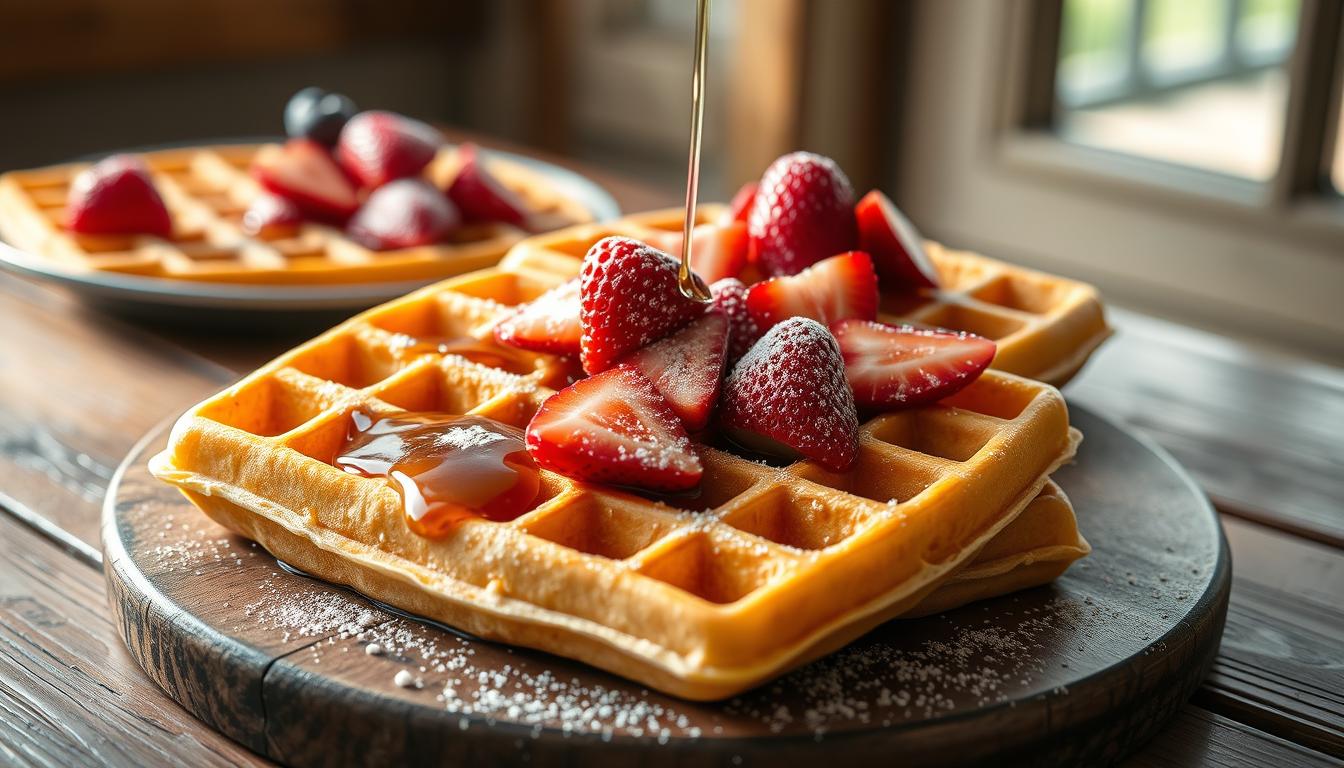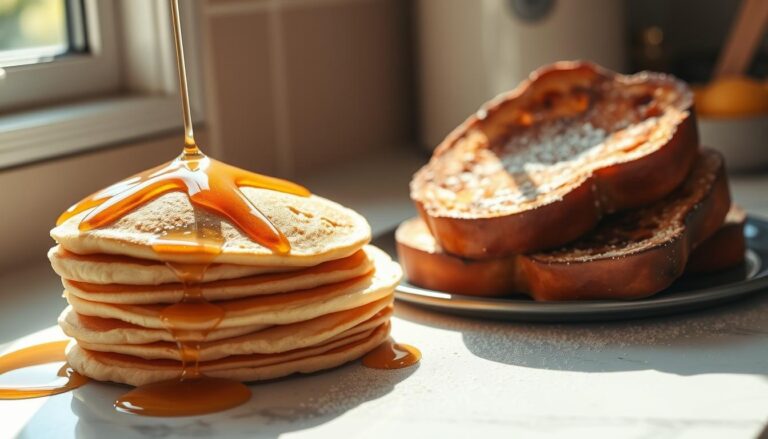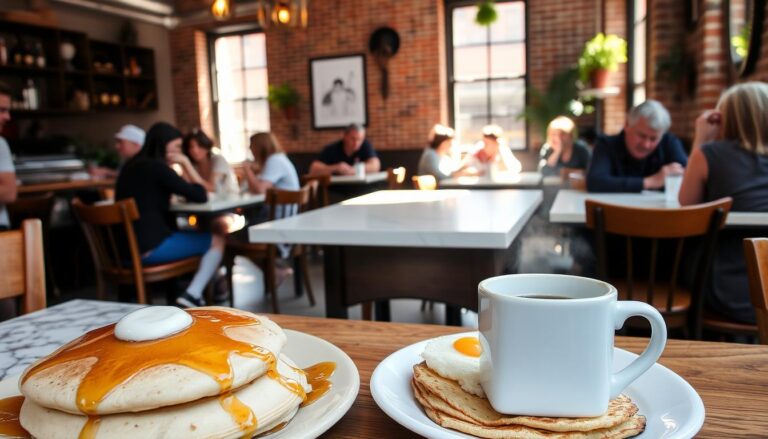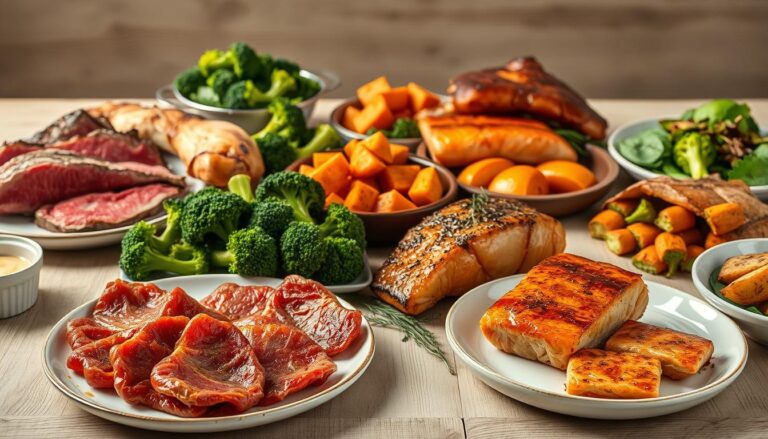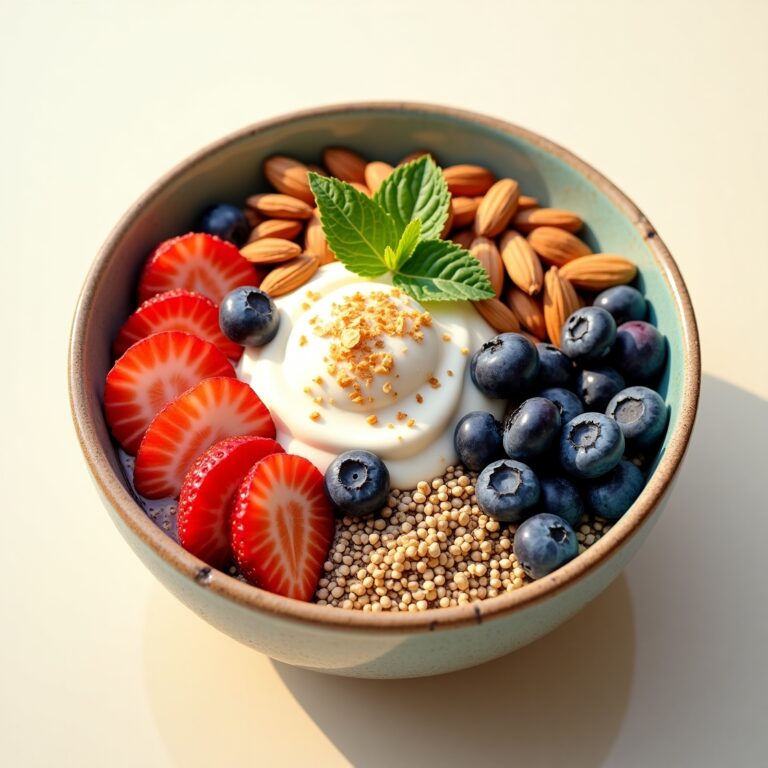The Best Waffle Recipe for a Delightful Breakfast
Starting your day with a delicious homemade breakfast is a great way to boost your energy and set a positive tone for the day.
There’s something special about enjoying a warm, crispy breakfast waffle with your favorite toppings, isn’t there?
A homemade waffle recipe is a simple yet effective way to create a delightful breakfast that everyone will love.
Key Takeaways
- Discover the secret to making the best breakfast waffles at home.
- Learn how to create a delicious homemade waffle recipe.
- Explore the benefits of having a great breakfast.
- Get tips on customizing your waffles with your favorite toppings.
- Find out how to make your breakfast more enjoyable and satisfying.
The History and Evolution of Waffles
The evolution of waffles is a fascinating story that involves culinary innovation and cultural exchange. Waffles have a storied past that dates back to medieval times, with their origins tracing back to the 13th century in Europe.
Origins of Waffles Around the World
Waffles were initially cooked between two hot irons, resulting in a crispy exterior and a fluffy interior. The concept of waffles spread across Europe, with different regions adopting and adapting the recipe to their local tastes. In the Netherlands, for instance, waffles were a popular street food, often topped with fruit or nuts. The Dutch brought their waffle recipes to America, where they evolved into a distinct breakfast dish.
How Waffles Became an American Breakfast Staple
The transformation of waffles into an American breakfast staple can be attributed to the invention of the waffle iron in the late 19th century. This innovation made it easier for households to cook waffles, leading to their increased popularity. By the mid-20th century, waffles had become a beloved breakfast option, often served with syrup, butter, fruit, or whipped cream. Today, waffles remain a versatile breakfast choice, with various toppings and flavors being experimented with across the United States.
The history of waffles is a testament to how culinary traditions can evolve and adapt over time, influenced by cultural exchange and technological advancements.
Essential Waffle-Making Equipment
The journey to crispy, golden waffles starts with understanding your equipment options. Making delicious waffles isn’t just about the ingredients; it’s also about having the right tools for the job.
Choosing the Right Waffle Iron
Selecting the perfect waffle iron can be daunting with so many options available. Your choice largely depends on the type of waffles you want to make and your personal preferences.
Belgian vs. American Waffle Irons
Belgian waffle irons produce thicker, deeper waffles, while American-style irons make thinner, more traditional waffles. Consider what type of waffle you prefer when making your choice.
Features to Look For
When choosing a waffle maker, look for features like non-stick surfaces, adjustable heat controls, and indicator lights. These features can make a significant difference in your waffle-making experience.
Other Tools You’ll Need
Apart from a waffle iron, you’ll need a mixing bowl, measuring cups, and a whisk to mix your batter. Having these kitchen equipment essentials on hand will make the process smoother.
Optional Equipment for Waffle Enthusiasts
For those who are serious about their waffle game, consider investing in a batter dispenser or a waffle sandwich maker. These tools can add variety and convenience to your waffle-making routine.
Understanding the Perfect Waffle Ingredients
Crafting the perfect waffle begins with understanding the role of each ingredient in the recipe. The quality and interaction of these ingredients significantly impact the final product’s taste, texture, and appearance.
The Role of Each Ingredient
Each component in a waffle recipe serves a specific purpose. Flour provides structure, leavening agents help the waffles rise, and fats and liquids contribute to moisture and flavor.
Flour Types and Their Effects
The type of flour used can significantly affect the waffle’s texture. All-purpose flour is a popular choice, offering a balanced protein content that supports structure without making the waffle too dense.
Leavening Agents
Leavening agents like baking powder are crucial for creating light and fluffy waffles. They release gases as they react with liquid ingredients, causing the batter to rise.
Fats and Liquids
Fats (such as butter or oil) and liquids (like milk or water) add moisture and flavor to the waffles. The choice between different types can affect the richness and tenderness of the final product.
Ingredient Substitutions and Alternatives
For those with dietary restrictions, ingredient substitutions can be a lifesaver. Whether you’re looking for dairy-free, gluten-free, or sugar alternatives, there are options available that can help.
Dairy-Free Options
Substituting dairy products with alternatives like almond milk or coconut milk can make waffles more inclusive. These options can slightly alter the flavor and texture.
Gluten-Free Adaptations
Using gluten-free flours can help those with gluten intolerance enjoy waffles. Blends that include rice flour, almond flour, or coconut flour can provide a similar texture to traditional waffles.
Sugar Alternatives
For those reducing their sugar intake, alternatives like honey or maple syrup can be used, though they may affect the batter’s consistency and the waffle’s flavor.
The Ultimate Waffle Recipe: Step-by-Step Instructions
With this ultimate waffle recipe, you’ll be able to create a delightful breakfast that’s sure to please. The process involves preparing the dry and wet ingredients separately before combining them and cooking the batter to perfection.
Preparing the Dry Ingredients
Start by whisking together 2 cups of all-purpose flour, 4 teaspoons of baking powder, 1 teaspoon of salt, and 1/4 cup of granulated sugar in a large bowl. The dry ingredients should be well combined to ensure even distribution of the leavening agents.
Mixing the Wet Ingredients
In a separate bowl, beat 2 large eggs and then mix in 1 cup of milk, 4 tablespoons of melted unsalted butter, and 1 teaspoon of vanilla extract. The wet ingredients should be smooth and fully incorporated.
Combining and Cooking Your Waffle Batter
Pour the wet ingredients into the dry ingredients and stir until just combined. The batter should still be slightly lumpy.
Resting the Batter
Let the batter rest for 5-10 minutes to allow the flour to absorb the liquid ingredients fully. This step is crucial for achieving a tender waffle.
Proper Cooking Techniques
Preheat your waffle iron according to the manufacturer’s instructions. Once hot, pour the appropriate amount of batter onto the center of the iron and spread it to the edges. Cook until the waffles are golden brown and crispy.
Visual Cues for Doneness
A perfectly cooked waffle should be golden brown and emit a crispy aroma. Check for doneness by looking for a slight sheen and ensuring the waffle is not pale or soggy.
| Cooking Time | Waffle Iron Temperature | Result |
|---|---|---|
| 3-5 minutes | Medium-High | Golden Brown |
| 5+ minutes | High | Crisp Exterior |
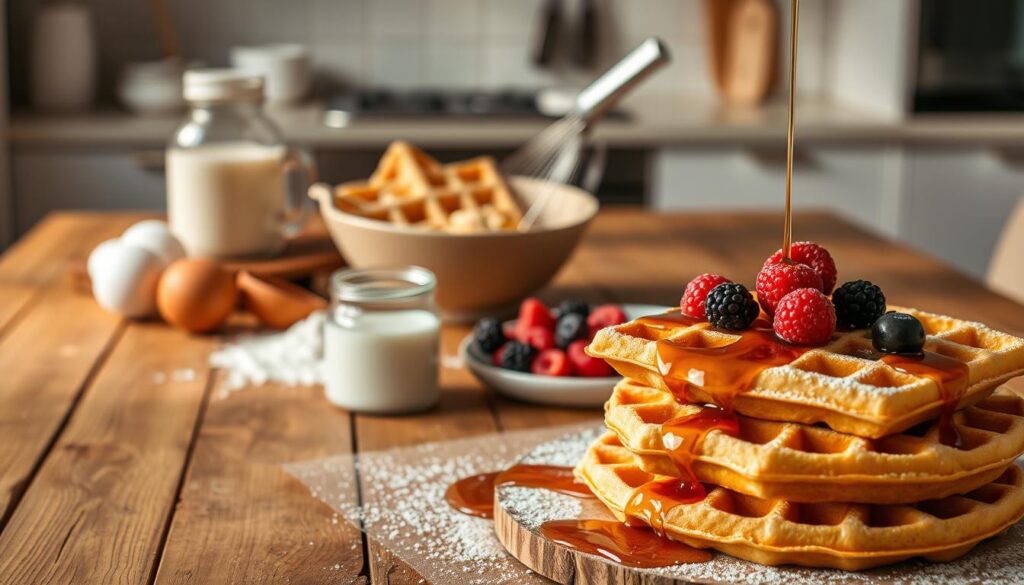
By following these step-by-step instructions, you’ll be able to create delicious waffles that are perfect for a delightful breakfast. Experiment with different toppings and accompaniments to make your waffle experience even more enjoyable.
Secrets to Achieving Light and Fluffy Waffles
The quest for the fluffiest waffle is a journey that involves understanding the science behind waffle texture. Achieving that perfect balance of crispiness on the outside and fluffiness on the inside is a matter of mastering a few key techniques and avoiding common pitfalls.
The Science Behind Waffle Texture
Waffle texture is largely determined by the interaction of ingredients and the cooking process. The leavening agents, such as baking powder, release gases when they come into contact with liquid ingredients and heat, causing the batter to rise. The structure of the waffle is then set by the cooking process, with the outside becoming crispy as the outside cooks quickly, while the inside remains fluffy if cooked just right.
Common Mistakes to Avoid
Even experienced cooks can fall into traps that lead to subpar waffles. Understanding these common mistakes can help you achieve better results.
Overmixing Issues
Overmixing the batter can lead to tough, dense waffles. This is because mixing develops the gluten in the flour, making the batter more rigid and less likely to rise properly. To avoid this, mix wet and dry ingredients separately and gently fold them together until just combined.
Temperature Control
The temperature of your waffle iron is crucial. If it’s too low, the waffles won’t cook properly and may be soggy. Too high, and they might burn on the outside before they’re fully cooked on the inside. Preheating your waffle iron and using a thermometer can help ensure the right temperature.
Batter Consistency Problems
The consistency of your batter is also vital. If it’s too thick, the waffles may be dense; too thin, and they might not hold their shape. Aim for a batter that’s thick but still pourable. Adjusting the liquid content can help achieve the right consistency.
By understanding the science behind waffle texture and avoiding common mistakes, you can significantly improve your waffle-making skills. With practice and patience, you’ll be creating light and fluffy waffles that are sure to impress.
Delicious Waffle Variations to Try
The versatility of waffles allows for countless variations, ensuring your breakfast is never boring. Whether you’re in the mood for something sweet or savory, waffle variations can cater to all tastes and dietary preferences.
Sweet Waffle Variations
Sweet waffles are a classic breakfast treat that can be enhanced with various ingredients. From fresh fruits to decadent chocolate chips, the possibilities are endless.
Chocolate and Fruit Additions
Adding chocolate chips or chunks to your waffle batter can create a deliciously rich treat. Fresh or dried fruits like blueberries, strawberries, or bananas can add natural sweetness and flavor.
- Dark chocolate and cherry for a sophisticated twist
- Blueberries and lemon zest for a refreshing flavor
- Banana and walnut for a hearty, filling option
Spiced and Flavored Waffles
Spices and extracts can elevate your waffles, adding depth and warmth. Consider cinnamon, nutmeg, or vanilla extract to give your waffles a unique flavor profile.
- Cinnamon apple for a fall-inspired treat
- Nutmeg and orange zest for a warm, citrusy flavor
- Vanilla bean for a classic, creamy taste
Savory Waffle Options
Savory waffles offer a delightful alternative to sweet breakfast dishes. They can be made with a variety of ingredients, from herbs and cheese to meats and vegetables.
Herb and Cheese Combinations
Incorporating fresh herbs and cheese into your waffle batter can result in a savory, satisfying breakfast. Consider combinations like chive and cheddar or rosemary and parmesan.
- Chive and cheddar for a classic, oniony flavor
- Rosemary and parmesan for a Mediterranean twist
- Garlic and mozzarella for a rich, savory taste
Meal-Worthy Savory Waffles
Savory waffles can be a meal in themselves when topped with ingredients like eggs, bacon, or avocado. They offer a versatile base for a satisfying breakfast or brunch.
- Egg and bacon for a hearty breakfast
- Avocado and salsa for a fresh, spicy kick
- Smoked salmon and cream cheese for a luxurious brunch
Seasonal Waffle Recipes
Seasonal ingredients can inspire a variety of waffle recipes, keeping your breakfast menu fresh and exciting throughout the year.
For example, pumpkin spice waffles in the fall, peppermint chocolate waffles during the winter holidays, or strawberry waffles in the spring. Summer might bring corn and herb waffles, perfect for a light, summery breakfast.
Perfect Toppings and Accompaniments for Your Waffles
From classic to creative, find the perfect waffle toppings for your taste buds. The right toppings can elevate your waffle experience, making it even more enjoyable and satisfying.
Classic Waffle Toppings
Start with the basics: maple syrup, fresh fruits, whipped cream, and powdered sugar are timeless favorites that complement the crispy exterior and fluffy interior of waffles. Maple syrup is a classic for a reason – it adds a rich, velvety texture and a deep flavor that pairs perfectly with the waffle’s crunch.
- Fresh berries
- Whipped cream
- Powdered sugar
- Maple syrup
Creative Topping Combinations
For those looking to experiment, consider unique combinations like caramelized bananas with pecans or strawberries with balsamic glaze. These creative pairings can add a new dimension to your waffle experience.
Making Your Own Syrups and Sauces
Homemade syrups and sauces can take your waffles to the next level. Here are a few ideas to get you started:
Fruit Compotes
Cook down fresh or frozen fruits with a bit of sugar to create a delicious compote. It’s perfect for topping waffles or yogurt.
Flavored Butters
Mix softened butter with flavorings like cinnamon or vanilla extract. Spread it on your waffle for an instant flavor boost.
Homemade Syrups
Create your own maple syrup alternatives using ingredients like honey, agave nectar, or even infused sugars. Experiment with different flavors to find your favorite.
How to Store and Reheat Waffles
Whether you’re meal prepping or saving leftovers, knowing how to store and reheat waffles is essential. Proper storage and reheating techniques can help maintain the quality and taste of your waffles.
Freezing Waffles for Later Use
Freezing is an excellent way to store waffles for extended periods. To freeze waffles, first, ensure they are completely cool. This prevents the formation of ice crystals that can affect texture.
Proper Freezing Techniques
Place the cooled waffles in a single layer on a baking sheet and put them in the freezer. Once frozen solid, transfer them to a freezer-safe bag or container. This method prevents waffles from sticking together.
Packaging for Freshness
Use airtight containers or freezer bags to store the frozen waffles. Removing as much air as possible before sealing can help prevent freezer burn.
Best Methods for Reheating Waffles
Reheating waffles can be done in several ways, each with its own benefits. The key is to reheat them in a way that maintains their crispiness.
Toaster Method
Using a toaster is one of the quickest ways to reheat waffles. Simply place the waffle in the toaster and heat until crispy. This method works best for frozen waffles.
Oven Reheating
For a larger batch, reheating in the oven can be more efficient. Preheat your oven to 350°F (175°C), place the waffles on a baking sheet, and heat for about 5-10 minutes, or until crispy.
Maintaining Crispness
To keep waffles crispy, avoid covering them with a lid or foil while reheating, as this can trap moisture. If you’re reheating multiple waffles, consider using a wire rack on your baking sheet to allow air to circulate around each waffle.
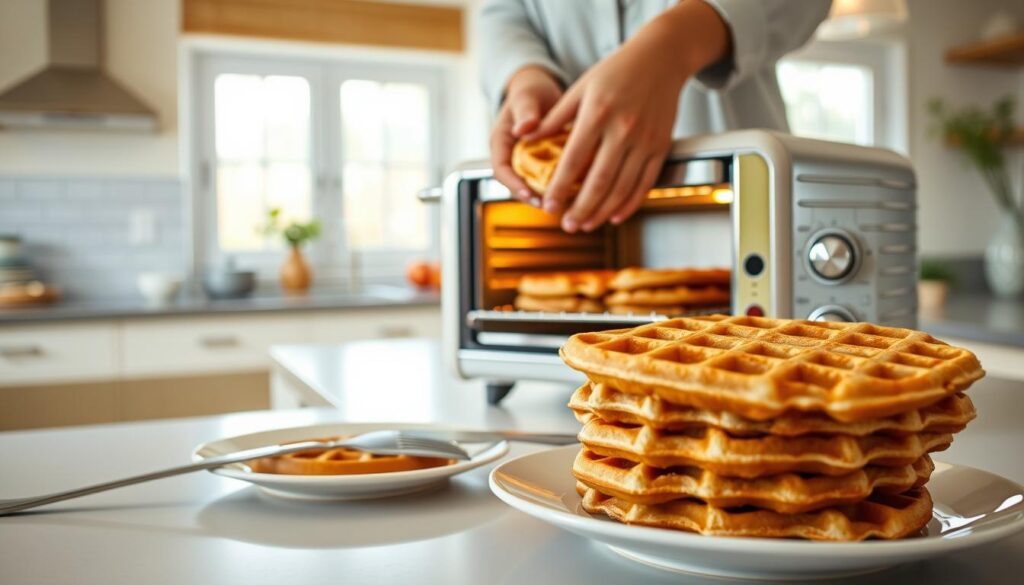
Troubleshooting Common Waffle Recipe Problems
Making waffles can sometimes be a trial-and-error process, but with a few troubleshooting tips, you can achieve perfect results every time. Whether you’re dealing with waffles that stick to the iron, are soggy or undercooked, or overly dense, understanding the causes and solutions can elevate your breakfast game.
Why Waffles Stick to the Iron
Waffles sticking to the iron is a common issue, often caused by insufficient greasing or a batter that’s too wet. To prevent this, make sure to grease your waffle iron properly before adding batter. You can use cooking spray or brush it with melted butter. If your batter is too wet, try reducing the liquid content slightly in your recipe.
Fixing Soggy or Undercooked Waffles
Soggy or undercooked waffles can be disappointing. This issue often arises from undercooking or using a batter that’s too wet. To fix this, ensure your waffle iron is hot enough before cooking, and consider cooking the waffles for a bit longer. Adjusting the batter’s consistency by adding a bit more flour can also help.
Addressing Overly Dense or Heavy Waffles
Overly dense or heavy waffles can result from overmixing the batter or using too much leavening agent. To avoid this, mix your wet and dry ingredients separately and gently fold them together. Be cautious with the amount of baking powder or baking soda you use, as too much can lead to an unpleasant texture.
Conclusion: Enjoying Your Homemade Waffle Breakfast
Now that you’ve mastered the art of making homemade waffles, it’s time to savor the fruits of your labor. A delicious breakfast is just a few steps away, and with your newfound skills, you can create a delightful morning meal that will become a staple in your household.
Imagine starting your day with a warm, crispy waffle, topped with your favorite ingredients, and enjoyed in the comfort of your own home. The joy of homemade waffles lies not only in their taste but also in the memories you create while sharing them with family and friends, enhancing your breakfast enjoyment.
As you continue to experiment with different flavors and toppings, you’ll discover new ways to make your homemade waffles even more special. So go ahead, get creative, and indulge in the pleasure of a perfectly cooked waffle, made with love and care, right in your own kitchen.

